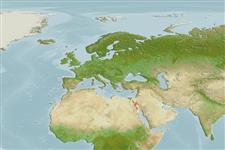Classification / Names
ຊື່ສາມັນ | ຄຳສັບຄ້າຍຄືກັນ | Catalog of Fishes(ຕະກຸນ, ຊະນິດ) | ITIS | CoL | WoRMS | Cloffa
>
Pleuronectiformes (Flatfishes) >
Soleidae (Soles)
Etymology: Aseraggodes: Greek, aggos, -eos, -ous = vessel, uterus, carapace of a crab + Greek, aseros, -a, -on = to remove the appetite (Ref. 45335); macronasus: Named for its unusually long anterior nostril.
Environment: milieu / climate zone / ລະດັບຄວາມເລິກ / distribution range
ນິເວດວິທະຍາ
ສັດທະເລ ກ່ຽວກັນຫີນ; ລະດັບຄວາມເລິກ 5 - 18 m (Ref. 95111). Tropical
Western Indian Ocean: Red Sea.
ຂະໜາດ / ນ້ຳໜັກ / Age
ການຈະເລີນເຕັມໄວ: Lm ? range ? - ? cm
Max length : 6.2 cm SL ຕົວຜູ້/ບໍ່ມີເພດ; (Ref. 95111)
Short description
ຕົວທີ່ໃຊ້ໃນການຈຳແນກຊະນິດ | ສະລີລະວິທະຍາ | ການວັດແທກຮູບຮ່າງລັກສະນະພາຍນອກຂອງດິນ,ສັດ,ປາ…
ຄີ (ໜາມ)ແຂງຢູ່ຫຼັງປາ (ທັງໝົດ) : 0; ຄີຫຼັງຂອງປາ (ຄີອ່ອນ) (ທັງໝົດ) : 63 - 69; ຄີ(ໜາມ) ແຂງຢູ່ຄີກົ້ນປາ
ກຸ່ມປາກະດູກແຂງ
ຄວາມຖີ່ຂອງກຸ່ມຖ່າຍທອດພັນ
ປາທີ່ມີການເຄື່ອນຍ້າຍຈາກທະເລໄປຫານ້ຳຈືດ ແລະນ້ຳຈືດຫາທະເລ
ປາທີ່ມີການເຄື່ອນຍ້າຍຈາກທະເລແລະໄປໄຂ່ຢູ່ນ້ຳຈືດ
ຄີກົ້ນຂອງປາ
ສັດທີ່ມີກະດູກສັນຫັຼງ
ການຖ່າຍທອດທາງກຳມະພັນຈາກພໍ່ແມ່ຫາລູກ: 0; ຄີກົ້ນຂອງປາ: 45 - 50; ສັດທີ່ມີກະດູກສັນຫຼັງ: 35 - 36. This species is distinguished by the following characters: D 63-69; A 45-50; in adults the dorsal and anal fin rays are branched, except for about first 20 rays of dorsal fin; caudal rays 18; lateral-line scales 66-72 (including 7 anterior to upper end of gill opening); vertebrae 35-36; dorsal pterygiophores anterior to fourth neural spine 11 or 12; body depth 2.7-2.75 in SL; head length 4.05-4.45 in SL; snout length 2.7-3.0 in head length; anterior nostril on ocular side tubular and very long, its length 3.6-4.1 in head length; ventral profile of head nearly straight, with very fine cirri on margin; caudal-peduncle length 13.0-14.5 in head length, its length 2.8-3.9 in SL; colour in alcohol of ocular side of adults light gray-brown, finely mottled with whitish; many scales rimmed posteriorly with dark brown; 2 dark brown blotches slightly larger than eye centered on lateral line, separated by a distance equal to head length; a few lesser dark brown spots on or near lateral line; dorsal and anal fins have translucent membranes and yellowish rays, some with faint small dark spots; caudal fin similar, but with small dark brown spots on basal scaled part of fin; a series of well-spaced, dark blotches of about eye size below base of dorsal fin and above base of anal fin; colour of holotype in life is yellowish gray, the scales narrowly dark-edged; many pale bluish gray spots, some in clusters forming irregular blotches, especially on head and anterior half of body; red from gill filaments showing faintly through operculum; a small white spot on opercular flap; dark blotches as described in preserved specimen; iris of eyes brown with spoke-like yellow lines, the pupil dark green, narrowly rimmed in yellow (Ref. 95111).
Body shape (shape guide): short and / or deep; Cross section: flattened.
This species was collected from sand or sand and rubble substrata near or within coral reefs. It is typically hidden in sand by day, but active at night, may move from sand to rock or
coral, however, it quickly retires to sand if alarmed. Skin toxin present and may be used for repelling attacks (Ref. 95111).
Life cycle and mating behavior
ການຈະເລີນເຕັມໄວ | ການສືບພັນ | ການວາງໄຂ່ | ໄຂ່ | ຄວາມດົກຂອງໄຂ່ປາ | ຕົວອ່ອນ
Randall, J.E., S.V. Bogorodsky and O. Mal, 2013. Four new soles (Pleuronectiformes: Soleidae) of the genus Aseraggodes from the western Indian Ocean. J. Ocean Sci. Found. 8:1-17. (Ref. 95111)
IUCN Red List Status (Ref. 130435: Version 2024-2)
Human uses
ເຄື່ອງມື
Special reports
Download XML
ແຫຼ່ງອີນເຕີເນັດ
Estimates based on models
Phylogenetic diversity index (ເອກະສານອ້າງອີງ
82804): PD
50 = 0.5000 [Uniqueness, from 0.5 = low to 2.0 = high].
Bayesian length-weight: a=0.00977 (0.00466 - 0.02049), b=3.07 (2.90 - 3.24), in cm total length, based on LWR estimates for this (Sub)family-body shape (Ref.
93245).
ຊັ້ນເຂດຮ້ອນ (ເອກະສານອ້າງອີງ
69278): 3.4 ±0.5 se; based on size and trophs of closest relatives
ຄວາມຢືດຢຸ່ນ (ເອກະສານອ້າງອີງ
120179): ສູງ, ປະຊາກອນຕຳ່ສຸດທີ່ໃຊ້ເວລາສອງໜ້ອຍກວ່າ 15 ເດືອນ (Preliminary K or Fecundity.).
Fishing Vulnerability (Ref.
59153): Low vulnerability (10 of 100).
🛈
